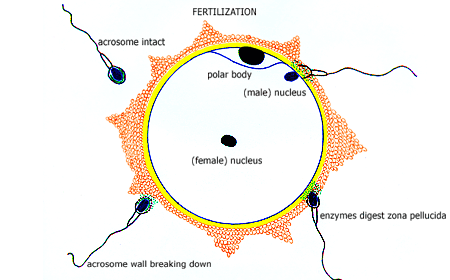|

Sperm undergoing maturation in the testes arrives in the epididymis about 74 days after initiating spermatogenesis. Epididymal spermatozoa normally have an intact acrosome (a large vesicle containing digestive enzymes that caps the nucleus of the sperm) and a tail (that become active as the sperm moves through the epididymis).
During erection, emission and ejaculation sperm moves from the epididymis into the vas deferens and is expelled through the penile urethra. The ejaculate (normally containing sperm) forms into a gel soon after release from the penis and then (normally) liquifies (within about 20-30 minutes).
Contractions of the female reproductive tract or thrusting (that occurs during intercourse) may be important for sperm to pass from semen into the cervical mucus. Sperm must then penetrate the cervical mucus, which has a microstructure that appears to become easier to traverse around the time of ovulation (probably due to changes in ovarian steroid hormones levels).
Sperm are normally found in the fallopian tube within 5 minutes of insemination. However, sperm must undergo a capacitation reaction (normally within the female reproductive tract) during which time they obtain the ability to undergo the acrosome reaction and bind the zona pellucida (shell of the egg). A physical characteristic of capacitated sperm is that they become hypermotile.
The mature (fertilizable) egg is within the ampullary portion of the fallopian tube within a few minutes of ovulation.
As a capacitated sperm approaches the egg the acrosomal membrane breaks down (the acrosome reaction) to release its enzymes. These acrosomal enzymes include hyaluronidase, cumulus dispersing enzyme and acrosin (also a protease)-- all of which are thought to play important roles in allowing fertilization to occur.
Fusion of the sperm’s (inner acrosomal) membranes and the egg’s (plasma) membrane takes place and the nucleus of the sperm is released into the egg’s cytoplasm. Fusion of the sperm and egg membranes triggers a “cortical reaction” within the egg that normally blocks subsequent fertilization by other sperm cells (so that only one of the sperm is able to fertilize the egg).
|

|